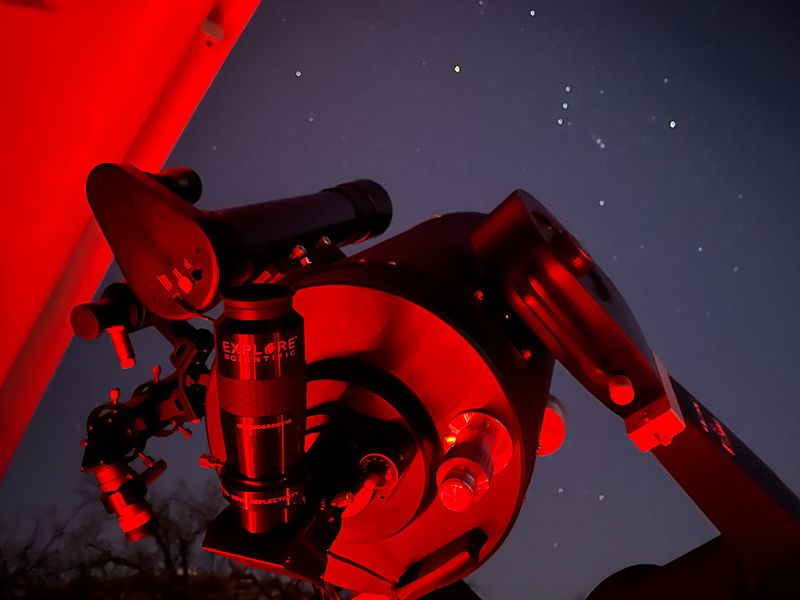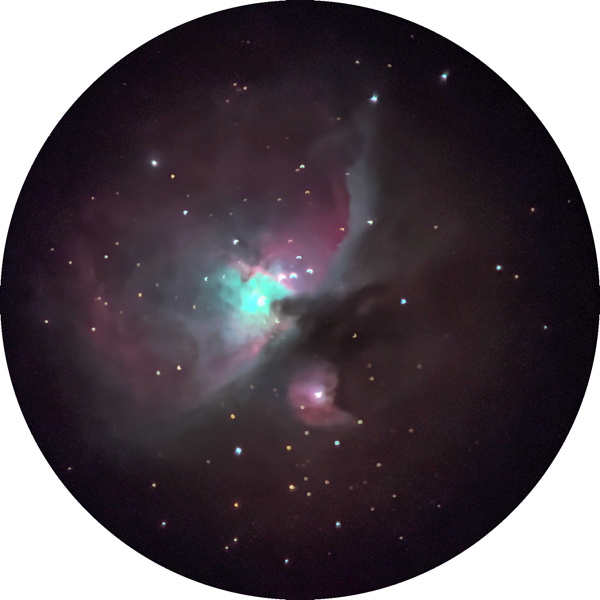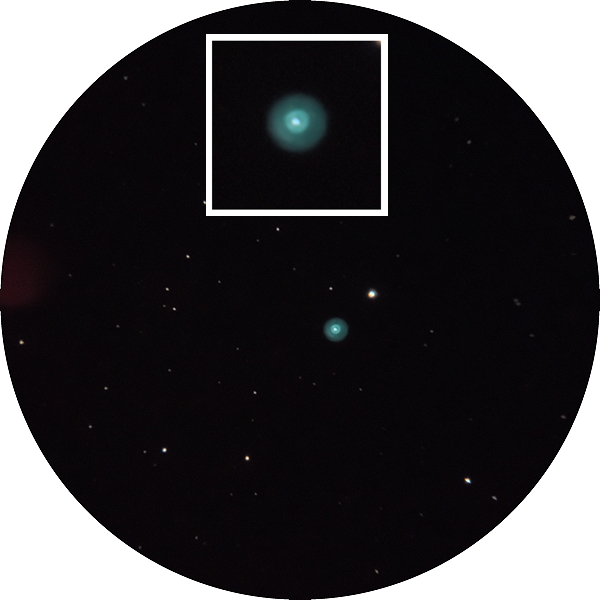iPhone Astrophotography Eskimo Nebula
Posted: 19 February 2022
|
Open: Friday, 18 February 2022, 1732 MST Temperature: 75°F |
Session: 1724 Conditions: Clear |
Equipment:
12" f/8 LX600 w/StarLock
2" 24mm UWA eyepiece
2" 5.5mm 100° eyepiece
2" 50mm eyepiece
1.25" 15mm eyepiece
Camera:
iPhone 13 Pro Max
1737 MST: LX600 ON, StarLock OFF, High Precision OFF.
Slewed to the star Alnitak in the constellation of Orion. It was not yet visible in the bright sky before sunset.
1744-1825 MST: Relaxed on the observatory patio bench while waiting for the sky to get dark.

1809 MST: Alnitak now visible in the 12" telescope, 102X.
1811 MST: Sunset.
1813 MST: Dome OFF (onto the PZT).
1826 MST: Slewed to M42 (Orion Nebula). The Trapezium star cluster was a nice view in the twilight sky, 102X. No nebulosity was visible yet.
1835 MST: Viewed the Trapezium, 443X.
Took this iPhone photo of the constellation of Orion and the 12" LX600 telescope using the iOS Camera app (Night Mode, 3 seconds, 1X lens).

1904 MST: Viewed the Trapezium, 443X. Using this high magnification, the nebulosity surrounding the Trapezium stars was very interesting to see.
1910 MST: Viewed M42 (Orion Nebula), 102X.
1912 MST: Zodiacal Light was becoming visible in the western sky.
Mounted the 2" 50mm eyepiece using the visual back (no diagonal) to get the maximum field-of-view. Viewed M42, 49X.
Mounted the iPhone 13 Pro Max on the 50mm eyepiece using the Levenhuk adapter.
1924 MST: StarLock ON.
Did some afocal 49X imaging of the Orion Nebula. The iOS Camera app would not lock at infinity when imaging M42. Using the iOS NightCap Camera app, I took this StarLock autoguided image (Long Exposure, Light Boost, ISO 10000, 1sec, 1 minute, 1X lens). The stars are distorted by this low quality eyepiece. Unfortunately, it is the lowest power eyepiece I have for the 12" telescope.

I then tried to image the Horsehead Nebula (IC434). Unfortunately, the telescope secondary mirror central obstruction took up too much of the field-of-view and was too dark in this dark region of the sky. It masked any useful image.
Removed the iPhone and viewed the Flame Nebula (NGC2024), 49X.
1952 MST: Viewed the Eskimo Nebula (NGC2392), 102X and 163X. Nice views.
Mounted the iPhone on the 15mm eyepiece. Took this StarLock autoguided image of the Eskimo Nebula using NightCap Camera (Long Exposure, Light Boost, ISO 10000, 1sec, 1 minute, 1X lens). The inset shows a magnified view of the Eskimo Nebula.

2005 MST: StarLock OFF.
The eastern sky was brightening from the rising waning gibbous Moon.
Viewed the Eskimo Nebula, 163X and 102X.
2012 MST: LX600 OFF.
2016 MST: Dome ON.
|
Close: Friday, 18 February 2022, 2022 MST Temperature: 48°F |
Session Length: 2h 50m Conditions: Clear |
Comments are welcome using Email. Twitter users can use the button below to tweet this report to their followers. Thanks.
Cassiopeia Observatory Home Page
Copyright ©2022 Michael L. Weasner / mweasner@me.com
URL = http://www.weasner.com/co/Reports/2022/02/19/index.html
